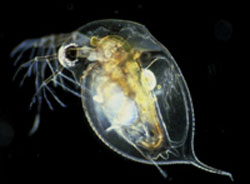Genome sequencing is for ecologists, too

The water flea Daphnia pulex is a commonly used model organism among ecologists and other environmental scientists. Photo by: P.D.N. Hebert, University of Guelph
An organism widely used for genetics-versus-environment studies has joined the panoply of mice, rats, dogs, humans and other species whose entire genomes have been sequenced.
At the Daphnia Genomics Consortium’s annual meeting in Bloomington this week, Indiana University and Joint Genome Institute scientists announced they’ve completed a “shotgun” sequence for Daphnia pulex, or the water flea, as it’s better known to high school biology students.
“Daphnia is important to the environmental sciences, where the goal is to understand the complexities of ecosystems by getting a handle on how species in natural settings respond genetically to their environments,” said Daphnia Genomics Project leader John Colbourne. “Ecologists and evolutionary biologists would also want to learn more about how genetic variation is important for adaptation and how populations survive in a changing world.”
Colbourne is a founding member of the Daphnia Genomics Consortium and the genomics director of the Center for Genomics and Bioinformatics at IU Bloomington.
The U.S. Department of Energy and the National Science Foundation funded the Daphnia project. Most of the sequencing work was done at DOE’s Joint Genome Institute Production Genomics Facility in Walnut Creek, Calif.
Shotgun sequencing involves breaking a whole genome into smaller, more digestible DNA segments, then sequencing each one. The Daphnia genome was sequenced over eight times to ensure better coverage of all 12 pairs of chromosomes.
Daphnia’s short generation time and small genome (a mere 200 million base pairs) makes it an ideal organism for laboratory and field studies of how environments influence — and how they’re influenced by — an organism’s genetics. The animals are common in lakes and ponds and have been used to monitor the health of aquatic environments. Members of the species can reproduce both with and without sex, which has important implications in evolutionary biology and ecology.
Species whose genomes have been sequenced are generally used for experiments in physiology and in developmental and cell biology, but rarely in ecology. Scientists are eager to exploit genomic technologies and genomic experimental approaches that have already revolutionized research in the human health sciences, with the goal of diagnosing the state of aquatic environments.
Despite their common name, water fleas are not insects but crustaceans, like lobsters and crabs. Daphnia is the first crustacean genome to be sequenced. Information from its genome will help biologists make sense of similarities and differences among the intensively studied genetic models of insects, which are evolutionary relatives of crustaceans.
“The genome sequences are being completed for several insects because they are important model organisms — like fruit flies — or because they are important in disease or agriculture,” said Jeffrey Boore, head of the evolutionary genomics program at the Joint Genome Institute. “And the Daphnia genome sequence will illuminate all of this by allowing us to infer the ground state from which the insect genomes evolved.”
Media Contact
All latest news from the category: Ecology, The Environment and Conservation
This complex theme deals primarily with interactions between organisms and the environmental factors that impact them, but to a greater extent between individual inanimate environmental factors.
innovations-report offers informative reports and articles on topics such as climate protection, landscape conservation, ecological systems, wildlife and nature parks and ecosystem efficiency and balance.
Newest articles

First-of-its-kind study uses remote sensing to monitor plastic debris in rivers and lakes
Remote sensing creates a cost-effective solution to monitoring plastic pollution. A first-of-its-kind study from researchers at the University of Minnesota Twin Cities shows how remote sensing can help monitor and…

Laser-based artificial neuron mimics nerve cell functions at lightning speed
With a processing speed a billion times faster than nature, chip-based laser neuron could help advance AI tasks such as pattern recognition and sequence prediction. Researchers have developed a laser-based…

Optimising the processing of plastic waste
Just one look in the yellow bin reveals a colourful jumble of different types of plastic. However, the purer and more uniform plastic waste is, the easier it is to…



